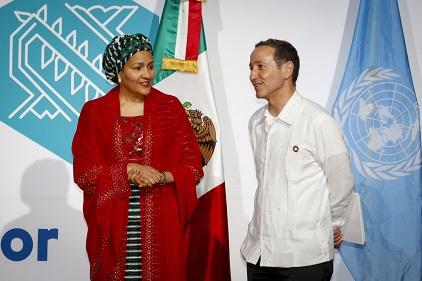
The UN Deputy Secretary-General, Ms. Amina Mohammed, with UNISDR chief and Secretary-General's Special Representative for Disaster Risk Reduction, Mr. Robert Glasser
By Denis McClean
GENEVA, 29 May, 2017 - Monitoring of progress in achieving agreed global targets for reducing disaster losses will get underway early in 2018, it was confirmed Friday, the closing day of the Global Platform for Disaster Risk Reduction in Cancun, Mexico.
This follows a data readiness review undertaken by 87 countries. Mr. Robert Glasser, the Secretary-General’s Special Representative for Disaster Risk Reduction, stated that the first cycle of monitoring progress on implementing the Sendai Framework for Disaster Risk Reduction will be launched in early 2018.
The Sendai Framework is the global plan for reducing disaster losses by 2030 and this first cycle will cover the periods 2015 to 2016, and 2017 to 2018. This cycle will end in March 2019.
Mr. Glasser said that much will depend on the availability and accessibility of the required data and it will need to be sufficiently consistent and comparable to allow meaningful measurement of progress and impact.
The Open-ended intergovernmental expert working group on indicators and terminology relating to disaster risk reduction, chaired by Ambassador Wayne McCook of Jamaica, recommended a review of the readiness of countries to report against the global targets of the Sendai Framework.
Across all regions, 87 UN Member States assessed their state of readiness to monitor and report, and specifically, the availability of national disaster-related data, disaster-related data gaps and the type of resources required to fill data gaps identified.
The Review also assessed countries’ current ability to set up baselines for measuring the global targets of the Sendai Framework. UNISDR has now prepared a Summary Report which presents the key findings of the Sendai Framework Data Readiness Review 2017.
Mr. Glasser speaking to a Plenary on Sendai Monitoring at the Global Platform last Fiiday, said that the findings show that data are available for 83% of reporting countries for Sendai Framework Target A, reducing mortality; and 66% for Target B, reducing the numbers of people directly affected.